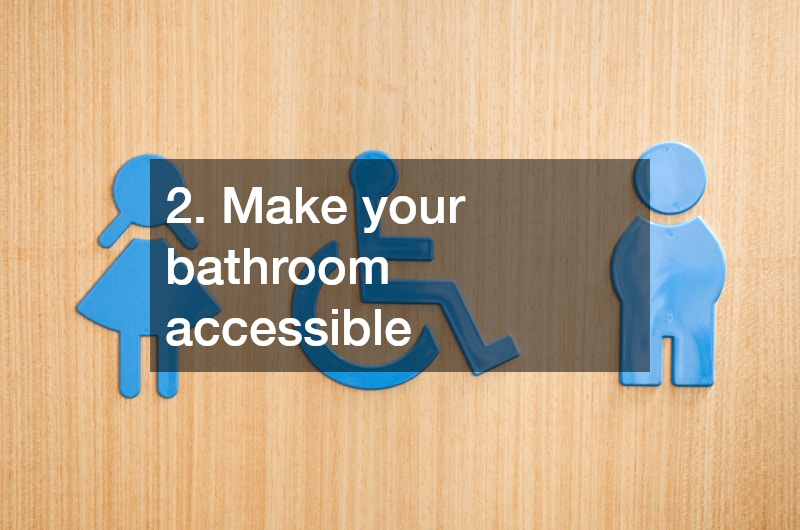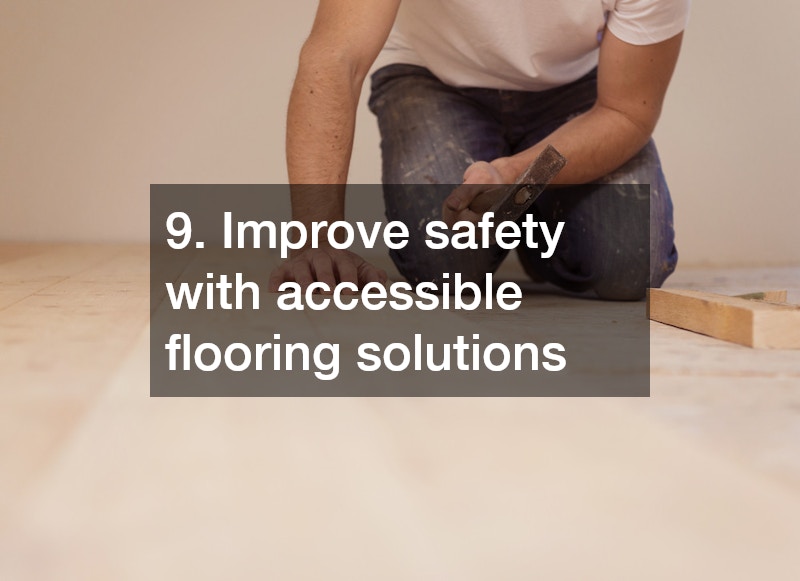When creating a space for your disabled child, you must see the world through their eyes. It’s not just about meeting standards, but also about creating a home that is comfortable and carefree. These renovations are designed to prevent potential hazards and promote independence, whether they involve installing ramps or updating bathrooms or doorways. Welcome to a journey that will transform your home into a safe haven for your children.
1. Install Home Assistive Technologies and Devices
Integrating assistive technology into your home will help your child achieve new levels of independence. The stairlift can transform multi-level homes by allowing easy and safe access to every room. This powerful tool will not only give your child the freedom to move around their home, but it also gives you peace of mind knowing that they are able to do so.
Smaller assistive devices, such as stairlifts, can have a significant impact on your child’s day-to-day routine. Consider voice-activated lighting controls or door handles that are easy to grip. These technologies might seem insignificant, but they can be a step towards a more independent life for children with disabilities within their familiar homes.
When planning your renovations, you should customize the changes to meet your child’s specific needs and abilities. Consult professionals who are familiar with the specifics of different disabilities so that you can ensure each modification isn’t just a reaction but rather a proactive step towards nurturing your child’s independence. It’s important to remember that it is not only about adapting the home to your child but also about creating an environment where they can grow.
2. Make your bathroom accessible

Renovating the bathroom in your home to meet your child’s requirements is a crucial part of accessibility renovation. A custom shower door will make a big difference. It allows for easy entry without tripping hazards or making it difficult to maneuver. They can be customized to fit any style or size, and they are able to accommodate a variety of mobility devices.
Safety and efficiency improvements like whole-house repiping should be considered, which can ensure consistent water pressure and temperature. You must ensure the safety of your children and make sure that you are contributing to a more sustainable home infrastructure. Modern piping can also be insulated, reducing the risk of burns caused by exposed hot pipes.
A bathroom renovation that focuses on safety and comfort will not only increase the value of your home but also give you peace of mind. The use of non-slip floors, grab bars, and lower sinks makes daily tasks easier and safer. It’s not just about adapting your home now but creating an environment that is supportive and accessible for your child as they grow.
3. Arrange or Modify Your Kitchen
Your kitchen is an important part of any accessibility renovation. Consult with experienced kitchen remodelers to transform your space into a comfortable and safe environment for your child. These professionals can suggest a design that allows wheelchair mobility and lower counters to easily access kitchen appliances and utensils.
Using adjustable systems, your kitchen can grow with your child. Elements such as adjustable cabinets and sinks are repositionable over time to provide a practical solution. Remodelers who are qualified will understand the importance of flexibility when it comes to long-term independence and functionality.
The kitchen can be equipped with technology that makes everyday tasks easier and more efficient. Every aspect of your kitchen, from faucets that have motion sensors to ovens that are easy to read, can help to increase the autonomy of your child. Not only should you make immediate changes, but also ensure that your kitchen is accessible in the future.
4. Waterproof Your Home
It is important to keep your child safe during an accessibility renovation. This includes protecting against water damage. Home waterproofing companies can be of great help in protecting moisture-prone areas. Basements, bathrooms, and even entranceways can be waterproofed to keep your home dry and safe, especially for children who have mobility issues.
You can work with professionals to identify water hazards, and then secure them in your renovation plan. It includes solutions to spills, splashes and barriers against moisture from the outside. Waterproofing will protect your renovations and prevent damage, which can result in costly repairs.
Waterproofing your home is not just a practical measure. It’s also a way to give you and your children peace of mind. Waterproofing a house correctly helps to maintain a clean and accessible environment. This reduces the risk of slips and accidents caused by wet surfaces. Your child will thrive in a home free of water damage, which is a great way to contribute to the success of your renovation.
5. Enhance Accessibility to Outdoor Areas
Access to outdoor areas is often the top priority when renovating for accessibility. A professional asphalt paving contractor can turn a bumpy drive into a smooth surface that is perfect for wheelchairs or walkers. This will reduce the chance of an accident and allow your child to take in the sunshine and fresh air.
Consider your home’s entrance and exit points in addition to the driveway. The garage door contractor will install an automated, wide door to make it easier for your child to enter and exit the home. This upgrade eliminates manual opening, which can be difficult for people with limited mobility.
Any renovation should aim to create an environment that is barrier-free, allowing your child to move about with confidence and safety. You can give your child greater freedom by focusing on outdoor spaces. From paving to automated door, each improvement contributes to creating a home that values and supports your child’s independent.
6. Replace Your Windows
The importance of window replacement in any accessibility renovation is often underestimated. Selecting windows that are simple to open and shut can increase a child’s independence. Choose windows that have handles you can easily grip, locks that are simple to operate, and navigation systems with smooth movements.
Replace your windows to improve your home’s comfort and safety. Double glazing and low-E windows can help regulate the temperature of your home more effectively, and block harmful UV rays. It keeps the home comfortable all year round, which is important for children who are sensitive to temperature changes.
Within the scope of renovation, consider the height and placement of windows. Windows should be placed at a height that allows your child to see the outside and enjoy natural light while seated. This can improve their quality-of-life. The goal is to create a space for your child that not only looks good, but also feels comfortable and works well.
7. Upgrade Entry and Exit points
The entry and exit points of your home should be considered when evaluating accessibility. The presence of barriers here can make it difficult for your child to enter or leave the house. You should consider the door’s width, threshold, and type. Automatic doors, or those that only require a minimal amount of force to open, can make a huge difference in the independence and access of a child.
It’s crucial to think about the future when modifying these key points in the home. It is easier for wheelchairs and walkers to use ramps that have gentle slopes instead of the traditional steps. While maintaining aesthetics, railings and non-slip surfaces can also enhance safety. Choose materials and designs that will not only last but also adapt to the changing needs of your child.
Take into consideration the technological advances that can make your home safer and easier to access. Smart locks enable keyless entry, and intercoms allow communication between different areas of the home and outside. By integrating these elements into the renovation, you can ensure that your child is able to navigate entrances with confidence and safety. This will foster a greater feeling of autonomy.
8. Improve Bedroom Accessibility
Renovations for improved bedroom accessibility can transform an ordinary room into a haven for your child. You can create custom solutions for your child by focusing on accessibility. Not only is it important to have a bedroom that’s easy to move around in, but also one that’s designed with safety and simplicity as the top priority.
Furniture that is thoughtfully designed will help you create an accessible bedroom. Think about incorporating adjustable beds that will allow your child to easily get into and out of the bed. A desk or dresser within easy reach can also promote confidence and independence in their own space. You can help your child feel comfortable and confident in their bedroom by maximizing accessibility and minimizing strain.
Attention to small details can have a big impact on accessibility. Included in this are door handles with a large grip area, light switches that are conveniently located, and flooring designed to cushion falls and promote mobility. The design of the child’s bedroom should be holistic.
9. Improve safety with accessible flooring solutions

The flooring is a critical aspect to consider when undertaking accessibility renovations. It is important to choose the right flooring for your child. This will help minimize any risks and keep them safe while they navigate their home. Choose materials that are slip-resistant and can withstand the weight of assistive devices. These materials are safer and easier to move around the house.
It’s also important to choose the flooring that will cushion a fall. Cork, rubber, or padded carpets can absorb impact more effectively than hardwood or tile. You’ll need to seal these surfaces to prevent moisture from getting in and to make them easy to clean. This will help maintain a healthy and allergy-free environment for your children.
It’s also important to ensure that your flooring promotes comfort and normalcy. Transitions between flooring types should be seamless to reduce the risk of tripping and make it easier for people who use wheelchairs or walkers. Choose warm colors and textures that your child will enjoy, and create a space in which they can play and live without barriers.
10. Consider Custom Home Design Whenever Necessary
Custom homes are the answer for families who need unique modifications to their accessibility renovation project. Customized designs allow you to customize your home according to your child’s specific needs. This ensures your home features are not only accessible but also aligned with the safety and independence of your child.
Custom home design also allows you to incorporate adaptive technology and layouts that will grow with your child. Every detail can be considered from the beginning, whether it’s incorporating cutting-edge assistive devices or planning future mobility needs. It is important to create a framework that will adapt to changing abilities and provide long-lasting accessibility.
The renovation process can be significantly impacted by partnering with experienced architects and builders who have experience customizing homes. They will understand how important it is to combine functionality and comfort in order to ensure that every room within your home promotes the autonomy of your child. The expertise of this team can turn your vision into a reality and create a safe haven for your child to thrive.
11. Do not forget to tidy up your space after every project
Post-renovation cleaning is as important as accessibility renovation. Don’t forget the cleanup after the builders have left. Dust and debris pose health risks and can obstruct any new modifications. Professional cleaning services will ensure that your home is as clean and hygienic as well as functional.
Your child’s security is enhanced by a well-maintained, organized home. It can be difficult to transition after a renovation if you leave clutter and tools out. Cleaning services for the home are geared towards cleaning up after renovations, removing any leftover construction materials, and allowing you to enjoy your newly renovated environment fully.
A clean home reflects a balance between functionality and care, enhancing your accessibility efforts. Not only is it important to ensure that your home promotes the well-being of your children, but also its aesthetic appeal. Professional cleaners can give your home that finishing touch and make it ready for immediate use by your family.
It’s important to see the world through your child’s eyes when creating a space for them. Renovations for your disabled child are not just about meeting standards but also about creating a home that is comfortable and carefree. These renovations are designed to prevent potential hazards and promote independence, whether they involve installing ramps, updating bathroom designs, or modifying doorways. Welcome to a journey that will transform your home into a safe haven for your children.
